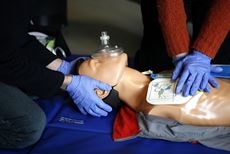

03/31/2016 10:31 AM EDT
03/31/2016 10:31 AM EDT
03/31/2016 10:31 AM EDT
03/31/2016 10:31 AM EDT
03/31/2016 09:56 AM EDT
03/31/2016 09:56 AM EDT
03/31/2016 09:56 AM EDT
National Institutes of Health
When someone's blood flow or breathing stops, seconds count. Permanent brain damage or death can happen quickly. If you know how to perform cardiopulmonary resuscitation (CPR), you could save a life. CPR is an emergency procedure for a person whose heart has stopped or is no longer breathing. CPR can maintain circulation and breathing until emergency medical help arrives.
Even if you haven't had training, you can do "hands-only" CPR for a teen or adult whose heart has stopped beating ("hands-only" CPR isn't recommended for children). "Hands-only" CPR uses chest compressions to keep blood circulating until emergency help arrives. If you've had training, you can use chest compressions, clear the airway, and do rescue breathing. Rescue breathing helps get oxygen to the lungs for a person who has stopped breathing. To keep your skills up, you should repeat the training every two years.
- Women in Cardiac Arrest May Be Less Likely to Receive Help (03/08/2016, HealthDay)
- Adult First Aid/CPR/AED Ready Reference (American Red Cross) - PDF
- Hands-Only CPR (American Heart Association)
- Learn CPR You Can Do It! (University of Washington, School of Medicine)Available in Spanish
- CPR - adult - slideshow Available in Spanish
- CPR - child 1 to 8 years old - slideshow Available in Spanish
- CPR - infant - slideshow Available in Spanish
- CPR: Adult
 (American Red Cross)
(American Red Cross) - CPR: Infant
 (American Red Cross)
(American Red Cross)
- CPR Facts and Stats (American Heart Association)
- ClinicalTrials.gov: Cardiopulmonary Resuscitation
 (National Institutes of Health)
(National Institutes of Health)
- Article: EVIDENCE-BASED EMS: Automated Chest Compression Devices. Does the evidence demonstrate...
- Article: Trial of Continuous or Interrupted Chest Compressions during CPR.
- Article: Eligibility and Disqualification Recommendations for Competitive Athletes With Cardiovascular Abnormalities:...
- CPR -- see more articles
- American Heart Association
- American Red Cross Available in Spanish
- Find a course (American Heart Association)
- National Heart, Lung, and Blood Institute

- CPR (For Parents) (Nemours Foundation)
- CPR: A Real Lifesaver (For Kids) (Nemours Foundation)
- Pediatric First Aid/CPR/AED Ready Reference (American Red Cross) - PDF























.png)











No hay comentarios:
Publicar un comentario